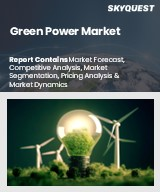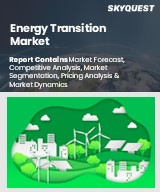
|
시장보고서
상품코드
1461364
재생에너지 인증서(REC) 시장 : 현황 분석 및 예측(2023-2030년)Renewable Energy Certificate Market: Current Analysis and Forecast (2023-2030) |
||||||
재생에너지 인증서 시장은 지난 10년간 태양광 패널 및 풍력 터빈과 같은 재생에너지 기술의 비용 절감으로 인해 예측 기간 동안 연평균 26.39%의 높은 성장률을 기록할 것으로 예상됩니다. 이로 인해 이러한 기술은 보다 친숙하고 비용 효율적이 되어 재생에너지에 대한 수요와 REC의 활용을 촉진하고 있습니다. 또한, 기후 변화와 환경 파괴에 대한 우려가 커지면서 더 깨끗하고 지속가능한 에너지원에 대한 사회적 인식과 수요가 증가하고 있습니다. 이산화탄소 배출량을 줄이고자 하는 기업이나 개인은 REC를 구매하여 온실가스 배출량을 상쇄할 수 있습니다.
에너지 유형에 따라 시장은 태양광발전, 풍력 발전, 수력 발전, 가스 발전으로 구분됩니다. 그 중에서도 수력 발전 프로젝트의 REC를 사용하면 기업과 개인이 재생에너지 생산을 지원하면서 이산화탄소 배출량을 상쇄할 수 있기 때문에 재생에너지 인증서 시장에서 수력 발전 부문이 큰 비중을 차지합니다. 수력 발전 산업은 100년 이상의 역사를 가지고 있으며, 이러한 오랜 역사 덕분에 기술이 확립되고 비용 효율성이 높아졌습니다. 여기에 정부의 인센티브와 정책이 더해져 REC 시장의 수력 발전 부문은 투자자와 소비자 모두에게 매력적인 선택이 되고 있습니다.
용량은 0-1,000KWH, 1,100-5,000KWH, 5,000KWH 이상으로 구분됩니다. 이 중 5,000KWH 이상 부문이 재생에너지 인증서 시장에서 큰 비중을 차지하는 이유는 이 부문이 더 많은 양의 전력을 필요로 하고 재생에너지원에 대한 투자 여력이 높은 중대형 기업들을 대상으로 하기 때문입니다. 이 부문의 기업들은 규모의 경제의 혜택을 누릴 수 있어 재생에너지 프로젝트의 비용 효율성을 높일 수 있습니다. 또한, 지속가능성 목표를 달성하고 친환경 제품 및 서비스에 대한 소비자 수요를 충족시키기 위해 대기업이 재생에너지로 전환해야 한다는 압력이 증가하고 있습니다. 마지막으로, 5,000KWh 이상 분야에서는 풍력, 태양광, 수력, 지열, 바이오매스 발전 등 다양한 재생에너지 선택이 가능하기 때문에 구매자는 자신의 필요에 가장 적합한 기술을 선택할 수 있습니다.
최종 용도에 따라 시장은 자율 규제와 규정 준수 시장으로 나뉩니다. 그 중에서도 자발적 부문은 환경적 영향에 대한 책임감을 갖고 지속가능한 에너지 미래로의 전환에 기여하고자 하는 개인과 기업을 대상으로 하는 재생에너지 인증서(REC) 시장이 압도적인 점유율을 차지하고 있습니다. 또한, 자발적 부문은 투명성과 추적성을 높여 구매자가 특정 재생에너지 프로젝트에서 REC를 선택하고 환경에 미치는 영향을 추적할 수 있도록 합니다. 이러한 향상된 관리 수준과 유연성은 특정 단체나 지역을 지원하고 자신의 브랜드 가치와 일치시키고자 하는 구매자에게 매력적입니다.
재생에너지 인증서 산업의 시장 도입에 대한 이해를 높이기 위해 시장은 북미(미국, 캐나다, 기타 북미), 유럽(독일, 영국, 네덜란드, 프랑스, 이탈리아, 스페인, 기타 유럽), 아시아태평양(중국, 일본, 인도, 기타 아시아태평양), 기타 세계 각국에서의 세계 존재를 기준으로 분석되었습니다. 유럽이 재생에너지 인증서(REC) 시장에서 큰 비중을 차지하는 이유는 고정가격 매입제도, 보조금, 세액공제 등 재생에너지 도입을 장려하는 정책 및 인센티브가 있기 때문입니다. 이러한 정책들은 재생에너지 프로젝트에 대한 투자와 REC 사용을 지원하는 환경을 조성하고 있습니다. 또한, 많은 유럽 국가에서는 기후변화와 환경 악화에 대한 우려로 인해 재생에너지원에 대한 국민들의 인식과 지지가 높습니다. 이 때문에 더 깨끗하고 지속가능한 에너지원에 대한 수요가 강하고 REC의 채택이 증가하고 있습니다. 또한, 유럽은 풍력이나 태양광과 같은 간헐적인 재생에너지를 대량으로 수용할 수 있는 전력망과 인프라가 발달해 있습니다. 이 때문에 기업이나 개인이 온실 가스 배출량을 상쇄하기 위해 REC를 구매하는 것이 더 쉬워지고 있습니다. 마지막으로, 유럽에서는 에너지 부문의 탈탄소화 추세가 강화되면서 재생에너지 기술에 대한 투자가 증가하고 있으며, 탄소 감축 목표를 달성하기 위해 REC가 활용되고 있습니다. 이러한 요인들은 세계 REC 시장에서 유럽의 지배적 지위로 이어지고 있습니다.
이 시장에서 활동하는 주요 기업으로는 Central Electricity Regulatory Commission, Green-e Energy, Western Area Power Administration, General Services Administration, U.S. Environment Protection Agency, Defense Logistics Agency Energy, World Business Council for Sustainable Development, ENGIE North America, RECS Energy Certificate Association, NextEra Energy Resources, LLC 등이 있습니다.
목차
제1장 시장 소개
- 시장 정의
- 주요 목표
- 이해관계자
- 제한사항
제2장 조사 방법 또는 가정
- 조사 과정
- 조사 방법
- 응답자 프로파일
제3장 시장 요약
제4장 주요 요약
제5장 세계의 재생에너지 인증서 시장 COVID-19의 영향
제6장 세계의 재생에너지 인증서 시장 매출, 2020-2030년
제7장 에너지 유형별 시장 분석
- 태양광발전
- 풍력발전
- 수력발전
- 가스발전
제8장 용량별 시장 분석
- -1,000 KWH
- 100-5,000 KWH
- 5,000 KWH 이상
제9장 최종 용도별 시장 분석
- 자발적
- 규정 준수
제10장 지역별 시장 분석
- 북미
- 미국
- 캐나다
- 기타 북미
- 유럽
- 독일
- 프랑스
- 영국
- 이탈리아
- 스페인
- 기타 유럽
- 아시아태평양
- 중국
- 일본
- 인도
- 기타 아시아태평양
- 세계 기타 지역
제11장 재생에너지 인증서 시장 역학
- 시장 성장 촉진요인
- 시장 과제
- 영향 분석
제12장 재생에너지 인증서 시장 기회
제13장 재생에너지 인증서 시장 동향
제14장 수요와 공급 분석
- 수요측 분석
- 공급측 분석
제15장 밸류체인 분석
제16장 가격 분석
제17장 경쟁 시나리오
- Porter's Five Forces 분석
- 경쟁 상황
제18장 기업 개요
- Central Electricity Regulatory Commission
- Green-e Energy
- Western Area Power Administration
- General Services Administration
- U.S. Environment Protection Agency
- Defense Logistics Agency Energy
- World Business Council for Sustainable Development
- ENGIE North America
- RECS Energy Certificate Association
- NextEra Energy Resources, LLC
제19장 면책사항
ksm 24.05.14A Renewable Energy Certificate (REC) is a tradable certificate that represents proof that one megawatt-hour (MWh) of electricity has been generated from a renewable energy source. The use of RECs allows individuals or organizations to offset their carbon footprint by supporting the production of renewable energy. Governments around the world have implemented policies and incentives to encourage the adoption of renewable energy sources. These policies can include tax credits, subsidies, and mandates that require a certain percentage of electricity to come from renewable sources. By providing financial support and regulatory frameworks, governments create an environment that encourages investment in renewable energy projects and the use of RECs.
The Renewable Energy Certificate Market is expected to grow at a strong CAGR of 26.39 % during the forecast period owing to the reducing cost of renewable energy technologies such as solar panels and wind turbines over the past decade. This has made these technologies more accessible and cost-effective, driving demand for renewable energy and the use of RECs. Additionally, growing concerns about climate change and environmental degradation have led to increased public awareness and demand for cleaner, more sustainable energy sources. Companies and individuals who want to reduce their carbon footprint can purchase RECs to offset their greenhouse gas emissions.
Based on energy type, the market is segmented into solar energy, wind power, hydro-electric power, and gas power. Amongst these, the hydro-electric power segment of the renewable energy certificate market has a significant share because the use of RECs from hydroelectric projects allows businesses and individuals to offset their carbon footprint while supporting the production of renewable energy. The hydropower industry has been around for over a century, and this long history has allowed the technology to become established and cost-effective. This, combined with government incentives and policies, has made the hydroelectric power segment of the REC market an attractive option for investors and consumers alike.
Based on capacity, the market is segmented into 0-1,000KWH, 1,100-5,000KWH, and more than 5,000KWH. Amongst these, the more than 5,000KWH segment has significant share in the renewable energy certificate market because this segment caters to medium to large-sized businesses that require larger amounts of electricity and have a greater ability to invest in renewable energy sources. Businesses in this segment can benefit from economies of scale, making renewable energy projects more cost-effective. Additionally, there is growing pressure on larger corporations to transition towards renewable energy sources to meet sustainability goals and respond to consumer demand for environmentally responsible products and services. Finally, the more than 5,000 KWh segment offers a range of renewable energy options, including wind, solar, hydroelectric, geothermal, and biomass power, allowing buyers to choose the technology that best suits their needs.
Based on end use, the market is segmented into voluntary and compliance. Amongst these, the voluntary segment of the Renewable Energy Certificate (REC) market has a dominant share because it caters to individuals or companies who want to take responsibility for their environmental impact and contribute to the transition towards a sustainable energy future. Additionally, the voluntary segment also offers greater transparency and traceability, allowing buyers to select RECs from specific renewable energy projects and track their environmental impact. This increased level of control and flexibility appeals to buyers who are looking to support specific causes or regions and align with their brand values.
For a better understanding of the market adoption of the renewable energy certificate industry, the market is analyzed based on its worldwide presence in countries such as North America (U.S., Canada, and the Rest of North America), Europe (Germany, UK, Netherlands, France, Italy, Spain, Rest of Europe), Asia-Pacific (China, Japan, India and Rest of Asia-Pacific), Rest of World. Europe has a significant share in the Renewable Energy Certificate (REC) market due to the policies and incentives that encourage the adoption of renewable energy sources, including feed-in tariffs, subsidies, and tax credits. These policies create an environment that supports investment in renewable energy projects and the use of RECs. Additionally, many European countries have high levels of public awareness and support for renewable energy sources due to concerns about climate change and environmental degradation. This has led to strong demand for cleaner, more sustainable energy sources and increased adoption of RECs. Moreover, Europe has a well-developed electricity grid and infrastructure that can accommodate large amounts of intermittent renewable energy sources such as wind and solar power. This makes it easier for companies and individuals to purchase RECs to offset their greenhouse gas emissions. Finally, there is a growing trend towards decarbonization of the energy sector in Europe, which has led to increased investment in renewable energy technologies and the use of RECs to achieve carbon reduction targets. These factors have contributed to Europe's dominant position in the global REC market.
Some major players operating in the market include Central Electricity Regulatory Commission, Green-e Energy, Western Area Power Administration, General Services Administration, U.S. Environment Protection Agency, Defense Logistics Agency Energy, World Business Council for Sustainable Development, ENGIE North America, RECS Energy Certificate Association, and NextEra Energy Resources, LLC.
TABLE OF CONTENTS
1.MARKET INTRODUCTION
- 1.1.Market Definitions
- 1.2.Main Objective
- 1.3.Stakeholders
- 1.4.Limitation
2.RESEARCH METHODOLOGY OR ASSUMPTION
- 2.1.Research Process of the Renewable Energy Certificate Market
- 2.2.Research Methodology of the Renewable Energy Certificate Market
- 2.3.Respondent Profile
3.MARKET SYNOPSIS
4.EXECUTIVE SUMMARY
5.GLOBAL RENEWABLE ENERGY CERTIFICATE MARKET COVID-19 IMPACT
6.GLOBAL RENEWABLE ENERGY CERTIFICATE MARKET REVENUE, 2020-2030F
7.MARKET INSIGHTS BY ENERGY TYPE
- 7.1.Solar Energy
- 7.2.Wind Power
- 7.3.Hydro-electric Power
- 7.4.Gas power
8.MARKET INSIGHTS BY CAPACITY
- 8.1.0-1,000KWH
- 8.2.1,100-5,000KWH
- 8.3.More than 5,000KWH
9.MARKET INSIGHTS BY END USE
- 9.1.Voluntary
- 9.2.Compliance
10.MARKET INSIGHTS BY REGION
- 10.1.North America
- 10.1.1.U.S.
- 10.1.2.Canada
- 10.1.3.Rest of North America
- 10.2.Europe
- 10.2.1.Germany
- 10.2.2.France
- 10.2.3.UK
- 10.2.4.Italy
- 10.2.5.Spain
- 10.2.6.Rest of Europe
- 10.3.Asia-Pacific
- 10.3.1.China
- 10.3.2.Japan
- 10.3.3.India
- 10.3.4.Rest of APAC
- 10.4.Rest of the World
11.RENEWABLE ENERGY CERTIFICATE MARKET DYNAMICS
- 11.1.Market Drivers
- 11.2.Market Challenges
- 11.3.Impact Analysis
12.RENEWABLE ENERGY CERTIFICATE MARKET OPPORTUNITIES
13.RENEWABLE ENERGY CERTIFICATE MARKET TRENDS
14.DEMAND AND SUPPLY-SIDE ANALYSIS
- 14.1.Demand Side Analysis
- 14.2.Supply Side Analysis
15.VALUE CHAIN ANALYSIS
16.PRICING ANALYSIS
17.COMPETITIVE SCENARIO
- 17.1.Porter's Five Forces Analysis
- 17.2.Competitive Landscape
18.COMPANY PROFILED
- 18.1.Central Electricity Regulatory Commission
- 18.2.Green-e Energy
- 18.3.Western Area Power Administration
- 18.4.General Services Administration
- 18.5.U.S. Environment Protection Agency
- 18.6.Defense Logistics Agency Energy
- 18.7.World Business Council for Sustainable Development
- 18.8.ENGIE North America
- 18.9.RECS Energy Certificate Association
- 18.10.NextEra Energy Resources, LLC



















